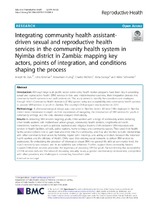| dc.contributor.author | Zulu, Joseph M. | |
| dc.contributor.author | Kinsman, John | |
| dc.contributor.author | Hurtig, Anna-Karin | |
| dc.contributor.author | Michelo, Charles | |
| dc.contributor.author | George, Asha | |
| dc.contributor.author | Schneider, Helen | |
| dc.date.accessioned | 2020-03-09T10:58:54Z | |
| dc.date.available | 2020-03-09T10:58:54Z | |
| dc.date.issued | 2019 | |
| dc.identifier.citation | Zulu, J. M., Kinsman, J., Hurtig, A. -., Michelo, C., George, A., & Schneider, H. (2019). Integrating community health assistant-driven sexual and reproductive health services in the community health system in nyimba district in zambia: Mapping key actors, points of integration, and conditions shaping the process. Reproductive Health, 16(1) doi:10.1186/s12978-019-0788-4 | en_US |
| dc.identifier.issn | DOI: 10.1186/s12978-019-0788-4 | |
| dc.identifier.uri | http://hdl.handle.net/10566/5201 | |
| dc.description.abstract | Introduction: Although large scale public sector community health worker programs have been key in providing sexual and reproductive health (SRH) services in low- A nd middle-income countries, their integration process into community health systems is not well understood. This study aimed to identify the conditions and strategies through which Community Health Assistants (CHAs) gained entry and acceptability into community health systems to provide SRH services to youth in Zambia. The country's CHA program was launched in 2010. Methodology: A phenomenological design was conducted in Nyimba district. All nine CHAs deployed in Nyimba district were interviewed in-depth on their experiences of navigating the introduction of SRH services for youth in community settings, and the data obtained analyzed thematically. Results: In delivering SRH services targeting youth, CHAs worked with a range of community actors, including other health workers, safe motherhood action groups, community health workers, neighborhood health committees, teachers, as well as political, traditional and religious leaders. CHAs delivered SRH education and services in health facilities, schools, police stations, home settings, and community spaces. They used their health facility service delivery role to gain trust and entry into the community, and they also worked to build relationships with other community level actors by holding regular joint meetings, and acting as brokers between the volunteer health workers and the Ministry of Health. CHAs used their existing social networks to deliver SRH services to adolescents. By embedding the provision of information about SRH into general life skills at community level, the topic's sensitivity was reduced and its acceptability was enhanced. Further, support from community leaders towards CHA-driven services promoted the legitimacy of providing SRH for youth. Factors limiting the acceptability of CHA services included the taboo of discussing sexuality issues, a gender discriminatory environment, competition with other providers, and challenges in conducting household visits. Conclusion: Strengthening CHAs' ability to negotiate and navigate and gain acceptability in the community health system as they deliver SRH, requires support from both the formal health system and community networks. Limitations to the acceptability of CHA-driven SRH services are a product of challenges both in the community and in the formal health system. | en_US |
| dc.language.iso | en | en_US |
| dc.publisher | Reproductive Health | en_US |
| dc.subject | Community care | en_US |
| dc.subject | Gender | en_US |
| dc.subject | Sexuality | en_US |
| dc.subject | Zambia | en_US |
| dc.subject | Taboo | en_US |
| dc.title | Integrating community health assistant-driven sexual and reproductive health services in the community health system in Nyimba district in Zambia: Mapping key actors, points of integration, and conditions shaping the process | en_US |
| dc.type | Article | en_US |

